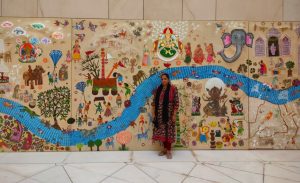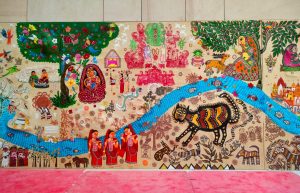Odia Artisan worked as Sutradhar of ‘People’s Wall’ inside New Parliament
TNH Exclusive
Bhubaneswar: The New Parliament in New Delhi has been inaugurated on Sunday, and it holds a special connection to Odisha.
Satyabhama Majhi, an accomplished Odia artisan, played a pivotal role as the Sutradhar (narrator) of the People’s Wall, which celebrates diverse art forms from across the country. The wall, situated near the Constitutional Hall of the new parliament, revolves around the theme of ‘Jan, Janani, and Janmabhumi’ (People, Mother, and Motherland) and is curated by Ramakrishna Vedala, secretary of Lalit Kala Akademi, New Delhi.
Satyabhama worked with over 70 women artisans from various parts of the country, each practicing different art forms, to collaborate on this project. Under the guidance of Satyabhama the women artisans created their artwork on the wall.
Hailing from Bhubaneswar, Satyabhama is proficient in various artistic expressions such as painting, installation art, sculpting, and photography. She has actively engaged with tribal communities to gain insight into their culture and way of life.
The People’s Wall showcases a splendid array of folk art and paintings, including Sujani Art, Kohbar art, Sohrai paintings, Sanjhi art, Pattachitra, Madhubani art, Saura painting, Santhal painting, dongaria art and textile, Gond painting, Kalighat Painting, Worli painting, and papier-mache, among others.
The artworks portrayed on the wall highlight the essence of India from Arunachal Pradesh to Gujarat giving a glimpse of Sunrise to Sunset.

Reflecting on her experience working in the new parliament, Satyabhama said, “It is a once-in-a-lifetime experience for me. I feel proud to have had the opportunity to work with 70 artisans from across the country and collaborate with them. To offer a glimpse into the rich history of Indian visual art, we utilized various folk, tribal, and traditional art forms to represent the concepts of people, motherhood, and motherland.”
She further emphasized that all the artworks and installations were crafted using environmentally friendly and organic materials, such as papier-mache, banana fiber pulp, and other indigenous binders. “The fundamental idea behind the artwork was to work with organic materials and avoid the use of plastic-based components in production. The paints and other materials were carefully chosen, drawing inspiration from diverse regional art-making practices in India,” she explained.
Highlighting the significant contribution of women artisans in immortalizing various art forms on the walls of the New Indian Parliament, she remarked, “Women artisans who have been working at the grassroots level were given the opportunity to showcase their creative works alongside award-winning artisans, and that has been truly remarkable.”
An art camp, held in Madhubani village in Bihar, brought together the selected artisans for this dream project. Satyabhama shared, “Across the country, numerous women artisans have been practicing different art forms, with some known and others still waiting to be highlighted. Before commencing the project, we organized an art camp where artisans from various parts of the country were invited to participate.”
Among the artisans from Odisha who contributed to the project are Rupali Ruchismita Kar, Telo Wadaka, Lahari Kundika, Jhili Gomango, Jyoti Maharana, Snehalata Maharana, and Abhipsa Pradhan. They made beautiful murals of Saura paintings, Santhal paintings, Dongaria art and textile.
Expressing her satisfaction, Satyabhama conveyed that all the artisans have done exceptional work in embellishing the new parliament building. Their collective efforts have truly transformed the space into a celebration of art.

Comments are closed.